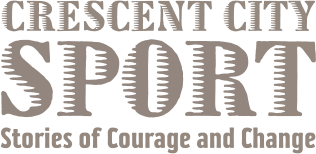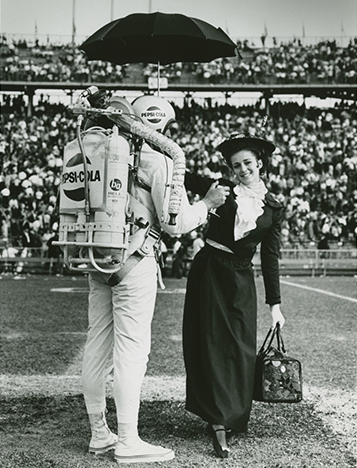





Excerpt from oral history interview with John Mecom Jr.
August 16, 2012
by Mark Cave, interviewer; Sarah Holtz, producer
gift of John W. Mecom Jr., 2012.0321
John Mecom Jr. describes some of the elaborate halftime shows at early Saints games.
Image: Stuntman Jim Pitts and woman dressed as Mary Poppins perform during Saints game; November 12, 1967; gelatin silver print by Roy Octave Trahan, photographer; The Historic New Orleans Collection, gift of Roy Trahan, 1990.16.1.1229
[Audio from YouTube video “Super Bowl IV Halftime Show (1970)” plays in background.]
John W. Mecom Jr: The one thing we did stress were halftimes. We had some of the greatest halftimes in the world. In fact, our halftime director had worked with Disney. And I think if it were up to him, we would have had three hours of halftimes and twenty minutes of football, but the league loved it because it helped them also. In fact, they hired Tommy [the halftime director] to do their first Super Bowl, first or second, and put on a number of shows for the league. I think that brought flavor to it.
[YouTube audio continues.
Super Bowl broadcaster Jack Whitaker: And with Bourbon Street, named for the Duke of Bourbon. But now reigned over by a king. His name: Al Hirt. His scepter: a golden horn. And here’s the king, taking us down the first street of dreams, Bourbon Street.]
Mecom: The one who really helped was Al Hirt, “Jumbo.” Al performed at halftime. He was a partner. He took a real interest in it. He’d travel with us. He was a great ambassador for the city and for the franchise. Al had a small piece of the team and he came to meetings. He didn’t interfere. He helped—god knows how many times he would have us all come down to the club after a game, especially if we won, and keep it open until whatever hours. He just, he lived and breathed the Saints. I think that transferred, I mean, that same thing transferred to an awful lot of fans.
[YouTube audio continues.
Whitaker: We are now going to be serenaded by a couple of river minstrels who many times have floated down the Mississippi. The minstrels: Al Hirt and Lionel Hampton. The song: “Do You Know What It Means to Miss New Orleans?” (Trumpet plays.)]
Mecom: Al Hirt, with the original group that sang “Up, Up and Away,” and Al was playing the trumpet. In the meantime, we had a balloon on the field, and at a certain part of the song, the balloon was supposed to fill up and drift out of the stadium. Well, the damn thing wouldn’t fill up.
[YouTube audio continues]
Mecom: We had great firework shows. In the meantime, we were in some kind of a controversy with Texaco—we, family—everyone was in a controversy with Texaco in Louisiana in those days. And ironically, one of the rockets went up out of the stadium, thank god. All the homes and everything were around Tulane Stadium, and this thing fell on top of the chief attorney for Texaco and burned part of his house down. He thought it was a conspiracy, but it wasn’t.
[Male Announcer: And the incomparable voice of our friend, Jim Nabors. Here is our national anthem. (Band begins playing “The Star-Spangled Banner” and Jim Nabors sings.)]
Mecom: We had Jim Nabors come in and sing the national anthem a couple times. They loved to come to New Orleans. They loved to come down there, come in on Thursday or Friday. We would treat them to great meals, great hospitality. The people of the city loved it, loved them, and they loved to perform. I don’t know that you could do a halftime show like we used to. We didn’t win a lot of games then, but we always won the halftime.
[Jim Nabors continues to sing “The Star-Spangled Banner.”]